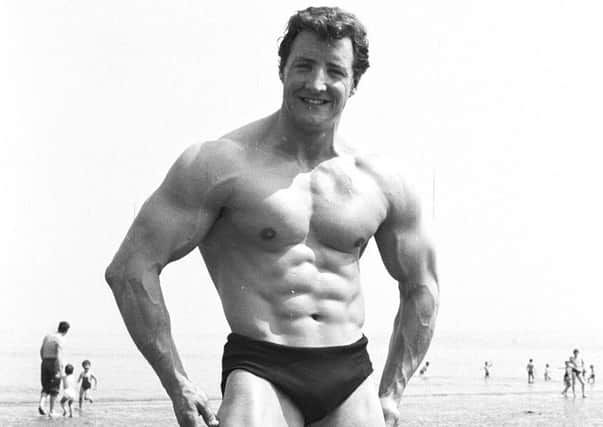Obituary: Norman Rough, architect who became Scotland’s best-known bodybuilder


Norman Roughwas the best-known Scottish bodybuilder of his generation and the sport’s iconic figure in Scotland from the early 1960s for more than a decade. Winner of numerous titles, his highlights included six consecutive Mr Scotland successes from 1965 to 1970 and a highly creditable sixth place in the Mr Universe contest in 1969 in London, where a certain Arnold Schwarzenegger claimed the crown. On the same occasion Norman was presented with the Maxalding Trophy for “most improved muscular development”.
The foundations for his route to the quest for physical perfection were laid at Daniel Stewart’s College in Edinburgh, where he distinguished himself as an all-round sportsman, representing the school at rugby and athletics, becoming senior Games’ champion in 1954 to add to his under 16 title the previous year. His celebrity as a “physical culturist” led to his appearing in a number of TV shows including Dr Finlay’s Casebook, as well as in various advertisements, including for brewers Tennents and Drybroughs –ironic given he was a lifelong teetotaller. In professional life he enjoyed an excellent reputation in architectural design, having set up the UK’s first independent consultancy in 1969, Rough Design, still flourishing today with son Grant at the helm. He was meticulous in his approach to the practice’s work, much of which dealt with refurbishments to bars, restaurants and hotels.
Advertisement
Hide AdAdvertisement
Hide AdNorman James Rough was born in Edinburgh, where he was brought up in the Barnton area, the only child of James, a sales executive, and Jean nee Gourlay. Sporting potential was revealed early when he won the under-6 “dash” at the local Gala Day sports, while later he shone, particularly at athletics, with wins in the high jump, hurdles and both sprints securing the coveted Stewart’s College Games’ championship. After school he represented the FP athletic club with distinction as a sprinter until around 21, when the gift of a book on weight training and athletics caused a change of direction in his sporting trajectory.
Having joined the Dunedin Weightlifting Club in Edinburgh’s East Meadows to pursue his interest in weights, he became hooked on bodybuilding after being inspired by a photograph of top American exponent Clarence Ross. The club was in an old wartime decontamination building whose facilities were extremely basic, far removed from today’s state-of-the-art gymnasia, and was run by Al Strachan, a competitive weightlifting enthusiast whose distaste for bodybuilders did not extend to refusing their weekly subscriptions. Norman soon progressed and within six months was persuaded to take part in a competition in Glasgow, where he was pleasantly surprised to finish 6th.
Suitably encouraged, his increased efforts paid off within a few years when he claimed his first titles in 1964 – Mr Physique, Mr Grand, Mr Caledonia – while a year later he won Mr Edinburgh, Mr South of Scotland and the first of his six Mr Scotland crowns. From then until 1970, when he retired from competition,he dominated the sport here and was well known internationally. To achieve and maintain the level where at his peak he stood 6ft 1in, weighed 265lb and boasted a 52in chest, 20in biceps and 28in thighs, called for huge commitment, determination and lots of training. In the build-up to contests he did six hour training sessions three times weekly for which large amounts of fuelling were required, including a daily intake of six meals and 8,000 calories, six litres of protein drinks and 30 vitamin supplements – and his daily porridge. He thought it important not to train to the point of exhaustion but instead feel “pleasantly tired”. Although no longer competing he continued training for years and was a familiar figure at Meadowbank Stadium.
When he left school he attended art college for about a year, having excelled in art at school,but left, disillusioned with the teaching. Thereafter he did a period of architectural training with Leslie Grahame-Thomson/MacDougall in their offices in Edinburgh’s New Town before doing design work with Gaskell and Chambers and other companies, establishing his own practice in 1969, initially in Portobello and now a stone’s throw from the old Dunedin Club. In the early 1970s he also set up, in partnership with others, the Norman Rough Health studio on the Promenade in Portobello and a “Slimtronic” Clinic in Broughton Street.
In 1963 he wed Patricia Brodie, a hairdresser, in Edinburgh, whom he met five years previously at The Bar-B-Que, in Forrest Road, a popular US-style cafe. The couple enjoyed 56 years of happy marriage, during which they had Grant and Lynn. After initially living in Currie, they moved to Portobello in 1971. Norman always hugely appreciated the support he received from Pat in pursuing his sport and the demands it made on family time. They enjoyed travelling and spent holidays in the US, Canada, Hong Kong, Singapore, Australia and Menorca.
He had a wide range of talents and interests, including drawing cartoons, painting, popular science, making fancy dress outfits and sports cars.
A devoted father, and grandfather, Norman was a true gentleman with a caring nature, calm temperament and strong sense of right and wrong. He is survived by his wife, children and grandchildren Sam, Lewis, Chloe, Fraser and Kim.
JACK DAVIDSON